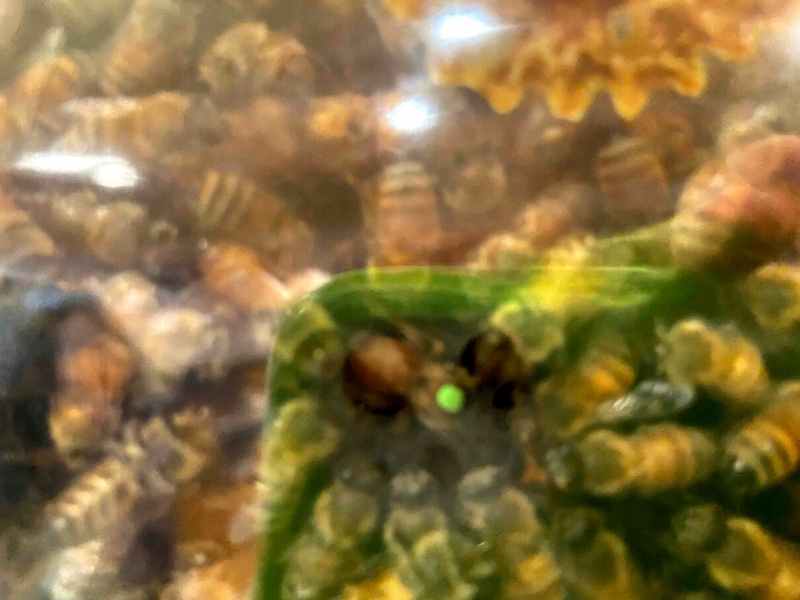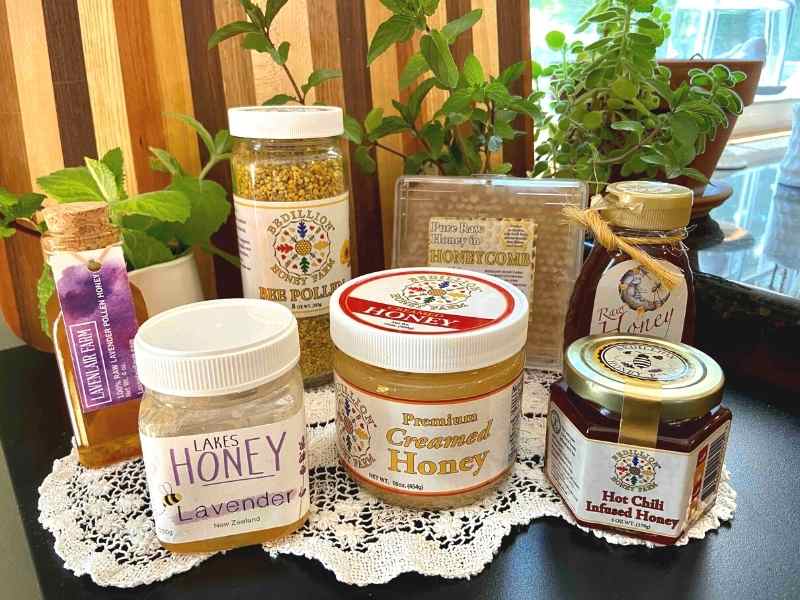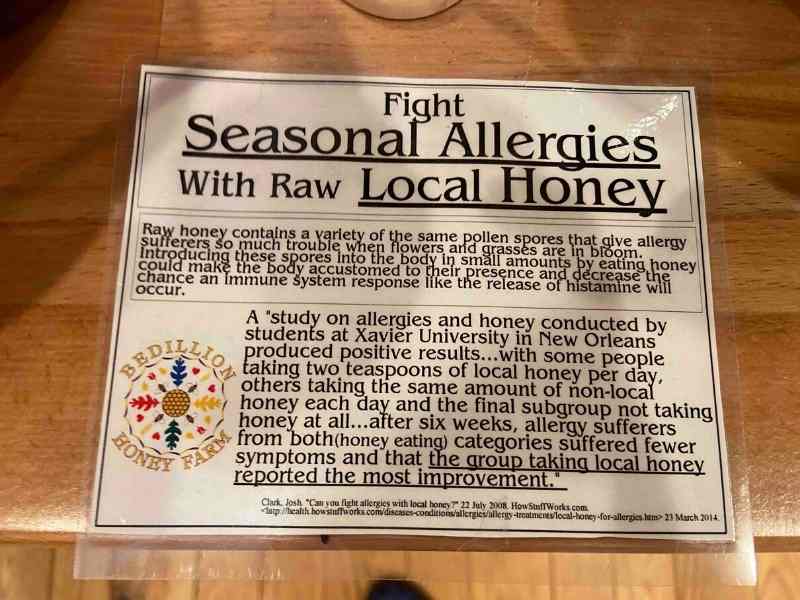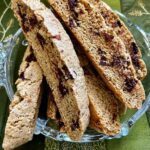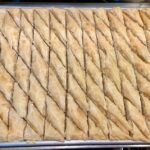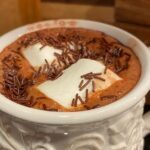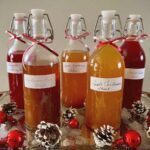The beautiful and complex world of honey bees is something to admire. Our appreciation for these little creatures that produce delicious honey and pollinate plants was heightened after visiting Bedillion Honey Bee Farm. We toured the farm with Sarah Bedillion, co-owner. The farm is located in Hickory, PA about 30 miles south of Pittsburgh in Washington County, PA.
”The biggest little honey shop in Pennsylvania.”
From the roadside, Bedillion Honey Bee Farm looks small. But once inside, there are many interesting things to explore! In addition to a wide variety of honey, there are resources about bees and beekeeping, books, beeswax, ornaments, and more. You can also observe honey bees at work, thanks to a framed box housing a hexagon-shaped honeycomb made from beeswax. This display enables viewers to safely watch the bees at work without fear of getting stung.
We learned so much about the amazing world of honey bees from Sara Badillion, starting with the queen bee.
The queen, the mother of bees, is an egg-laying machine. The queen bee literally lays thousands of eggs in a single day. In the hive exhibit, we observed that the queen is slightly larger than a worker bee. Badillion makes her easily recognizable to visitors by painting a green spot on her thorax. The thorax is the back of the bee, just between her wings.
As the queen inspects the cells in the comb, she will select the right-sized cell in which to lay eggs. A healthy queen decides which eggs will be fertilized. Non-fertilized eggs become males, also known as drones. Fertilized eggs become females, who will mature to be worker bees or potentially a queen bee.
Nutrition is important for the development of bees, starting with royal jelly.
Royal jelly is a secretion produced in the head glands of nurse bees and is fed to all the larvae in the colony for the first few days, regardless of sex or caste. Worker larvae are then switched to a diet of honey and pollen, while the queen bee larvae will continue to be fed royal jelly throughout her life.
A strong healthy bee colony occurs when collecting nectar takes place in the spring and autumn.
Nectar is primarily made up of water as bees pursue wild forage from blossoming trees and wildflowers. When a worker bee locates a good source of nectar or pollen, she will return to the hive to perform a waggle dance. This dance lets her nest mates know that she has found a good source of nectar. The dance also provides direction as to the location of the source.
Once the bees have completed the process of collecting nectar and producing honey, the honey is then harvested.
The majority of nectar gathering halts in the summer as moisture levels are low and there are few flowers or trees blossoming. The honey harvesting process begins by removing excess frames of honey and cutting off the beeswax caps to reveal the honey. The honeycomb frames are put into a centrifuge that spins the comb, which employs gravity to draw the honey to the bottom. After the “liquid gold” has been spun out of the honeycomb, it is time to strain and bottle. Regular honey can undergo a variety of processes that can sometimes remove beneficial nutrients like pollen and reduce the honey’s antioxidant levels.
Managing beehives includes inspecing the boxes, extracting honey, and ensuring that bees have the proper amount of space for honey production.
Sara was gracious to film her honey bees in action. It was fascinating to learn that the honey bees know Sara’s scent, as many were swarming around her while filming and she did not get stung.
Raw honey retains most of the beneficial nutrients and antioxidants that it naturally contains and has no additives, preservatives, or other ingredients — making it the real deal.
There are many varieties of honey. Honey varieties include: Sweet Clover, Buckwheat, Lavender, Spring Blossom, Wildflower, Hot Chili Infused, Japanese Knotweed, and Creamed Honey. The light to dark colors, grade, and viscosity depend upon the wildflowers where the nectar was collected from in the spring and the fall.
There are many beneficial uses of honey.
- Honey can be used medicinally. Some clinical research shows that honey may help heal wounds and burns, fight infections, and alleviate cold and flu symptoms.
- For seasonal allergies, 1-2 teaspoons of locally sourced honey taken daily may shorten allergic reactions or help alleviate allergic reactions altogether.
- Honey masks are a natural cosmetic that contains small amounts of gluconic acid and other alpha-hydroxy acids. These acids gently remove dead skin cells, moisturize, and brighten complexion.
This is an Elixir recipe I have shared with family and friends for years during the cold, flu, and allergy seasons.
Bragg’s Apple Cider Elixir
- 1 tablespoon Bragg’s Organic Apple Cider Vinegar with the mother (see note)
- 1 tablespoon fresh lemon juice
- 1/4 teaspoon of fresh grated ginger
- 1 tablespoon raw honey
- 1/4 teaspoon of ground cinnamon
- Dash of cayenne pepper
- 1/2 – 1 cup of hot water
Mix ingredients in a coffee cup and add hot water. Stir and enjoy while warm.
Note: Apple Cider Vinegar with the “mother” is a cloudy vinegar with enzymes, nutrients, and beneficial bacteria. It can be found in your local grocery, health food store, and online.
We appreciate Sara sharing her time and knowledge of bees and beekeeping with us. Buying honey locally can help support our beekeepers who are committed to selling honey and educating communities about the importance and value of bees. Beekeepers like Sara can also help those who would like to start their own personal or commercial venture into beekeeping. You can learn more about Bedillion Honey Farm at bedillionhoneyfarm.com
This experience was shared by OPL Naturalist Yvonne Dwyer.
Learn more about Yvonne.


